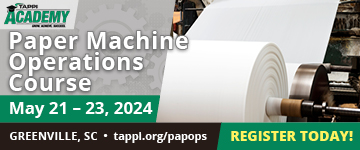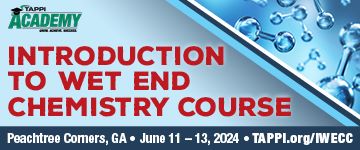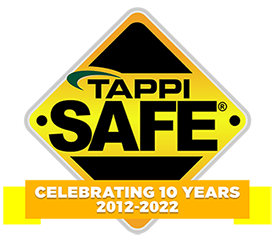 Search
Search
Use the search bar or filters below to find any TAPPI product or publication.
Filters
Content Type
Publications
Level of Knowledge
Collections
Journal articles

Magazine articles

Effects of different ammonium lignosulfonate contents on the crystallization, rheological behaviors, and thermal and mechanical properties of ethylene propylene diene monomer/polypropylene/ammonium lignosulfonate composites, TAPPI Journal January 2020
ABSTRACT: Thermoplastic elastomer (TPE), made from ethylene propylene diene monomer (EPDM) and polypropylene (PP) based on reactive blending, has an excellent processing performance and characteristics and a wide range of applications. However, there are currently no reports in the literature regarding the usage of TPE in making composite boards. In this paper, EPDM, PP, and ammonium lignosulfonate (AL) were used as the raw materials, polyethylene wax was used as the plasticizer, and a dicumyl peroxide vulcanization system with dynamic vulcanization was used to make a new kind of composite material. This research studied the influences of the AL contents on the crystallization behaviors, rheological properties, thermal properties, and mechanical properties of the composites. The results showed that the AL content had a noticeable impact on the performance of the composite board. Accordingly, this kind of composite material can be used as an elastomer material for the core layer of laminated flooring.
Journal articles

Magazine articles

Control of continuous digester kappa number using generalized model predictive control, TAPPI Journal September 2024
ABSTRACT: Kappa number variability at the digester impacts pulp yield, physical strength properties, and lignin content for downstream delignification processing. Regulation of the digester kappa number is therefore of great importance to the pulp and paper industry. In this work, an industrial application of model-based predictive control (MPC), based on generalized prediction control, was developed for kappa number feedback control and applied to a dual vessel continuous digester located in Western Canada. The problem was complicated by the need to apply heat at multiple locations in the cook. In this study, the problem was reduced from a multiple to a single input system by identifying three potential single variable permutations for temperature adjustment. In the end, a coordinated approach to the heaters was adopted. The process was perturbed and modeled as a simple first order plus dead time model and implemented in generalized predictive control (GPC). The GPC was then configured to be equivalent to Dahlin’s controller, which reduced tuning parameterization to a single closed loop time constant. The controller was then tuned based on robustness towards a worst-case dead time mismatch of 50%. The control held the mean value of the kappa number close to the setpoint, and a 40% reduction in the kappa number’s standard deviation was achieved. Different kappa number trials were run, and the average fiberline yield for each period was evaluated. Trial results suggested yield gains of 0.3%•0.5% were possible for each 1 kappa number target increase.
Journal articles

Magazine articles

Editoral: Investing in the future: Writing and peer-reviewing for TAPPI Journal, TAPPI Journal July 2024
ABSTRACT: Those who actively participate in TAPPI realize how much there is to gain from the networking, educational resources, career development, and other opportunities that come with this involvement. One important opportunity is the ability to share your work and expertise with others in your field, and an excellent way to do this is by taking part in the TAPPI Journal peer-review process, either as an author or a reviewer or both.
Magazine articles

A guide to developing a best management practices (bmp) plan for spent liquor, part II, TAPPI JOURNAL, December 1999, Vol. 82(12)
A guide to developing a best management practices (bmp) plan for spent liquor, part II, TAPPI JOURNAL, December 1999, Vol. 82(12)
Journal articles

Magazine articles

Three-dimensional visualization and characterization of paper machine felts and their relationship to their properties and dewatering performance, TAPPI Journal July 2021
ABSTRACT: Polymeric felts are commonly used in the papermaking process on the paper machine wet end, in the press section, and in the dryer section. They provide an important function during paper manufacturing, including as a carrier or support; as a filter media assisting with water removal on the paper machine; in retention of fibers, fines, and fillers; and in some applications, such as tissue and towel, to impart key structural features to the web. These felts can have highly interwoven complex internal structures comprised of machine direction and cross-machine direction yarns of varying sizes and chemical compositions. Here, we present a non-intrusive three-dimensional (3D) image visualization method using advanced X-ray computed tomography (XRCT). This method was used to characterize the complex 3D felt structure and determine the water removal characteristics of some commonly used paper machine felts. The structural features analyzed include porosity; specific pore-yarn interfacial surface area; 3D pore size distribution; 3D fiber or yarn-size distribution; and their variations through the thickness direction. The top, middle, and bottom layers of the felt have very different structures to assist with water removal and impart paper properties. The size distribution of the yarns, as well as the pores in the different layers of the felt, are also inherently different. These structural features were non-intrusively quantified. In addition, variation in the structural characteristics through the thickness of the felts and its potential role in papermaking is explored. In addition to the 3D structural characteristics, permeability characteristics and water removal characteristics, including rewetting of select felt samples, have also been experimentally determined. It is interesting to observe the relationship between key structural features and permeability and water removal characteristics. These relationships can provide additional insights into press felt design, as well as ways to improve product properties and the dewatering efficiency and productivity of the paper machine.
Journal articles

Magazine articles

Economic and competitive potential of lignin-based thermoplastics using a multicriteria decision-making method, TAPPI Journal September 2022
ABSTRACT: As a result of new lignin extraction plants hatching and increasing volumes of technical lignin becoming available, a variety of lignin derivatives, including phenolic resins and polyurethane (PU) foams, are reaching the marketplace or being used as intermediate products in many industrial applications. In the spectrum of possible lignin derivatives, thermoplastics appear particularly attractive due to a symbiosis of market, policy, and technology drivers. To assess the preferredness for lignin-based thermoplastics, this paper adapted a risk-oriented methodology formerly applied to assess lignin usage in various applications (phenol-formaldehyde [PF] resins, PU foams, and carbon fiber applications) to the case of lignin-based thermoplastics using hydroxypropylated lignin (HPL) and miscible blends of lignin and polyethylene oxide (PEO). The HPL is considered for garbage bags and agricultural films applications, while lignin-PEO blends are used as replacement for acrylonitrile butadiene styrene (ABS) in applications such as automotive parts. In the methodology, two phased-implementation strategies were defined for each thermoplastic derivative, considering perspectives for profit maximization (90 metric tons/day integrated units) and revenue growth (350 metric tons/day overall capacity), which were considered for implementation within a softwood kraft pulping mill. A set of six criteria representative of the main economic and market competitiveness issues were employed, and their respective importance weights were obtained in a multicriteria decision-making (MCDM) panel.Early-stage techno-economic estimates were done as a basis for the calculation of decision criteria. Compared to product derivatives previously assessed, capital investment for thermoplastic strategies appeared marginally higher due to the required lignin modification steps (on average 30% higher at similar capacity, and 6% for higher-scale revenue diversification strategies). Higher operating costs were also observed due to increased chemical expenses for all thermoplastic strategies, which are ultimately balanced by revenues associated with targeted thermoplastic products, leading to greater annual margins and cash flow generation over the project lifetime for thermoplastic strategies compared to other product applications (58% to 66% higher on average, at similar scale). Benefits of improved economics were reflected in economic criteria, internal rate of return (IRR), and cash flow on capital employed (CFCE), as well as in the price competitiveness criterion, CPC. Overall, the combination of relatively high lignin content in the plastic formulation and the less costly modification method contributed to lignin-PEO strategies, gaining the top two rankings. Based on their overall scores, both strategies defined for HPL would also integrate the group of “preferred” strategies, but are outranked by strategies that consider lignin positioning on PU foam applications.
Magazine articles

Editor's Note: Jim Atkins: Technology, training & transition
Editor's Note: Jim Atkins: Technology, training & transition, TAPPI JOURNAL September 2011
Journal articles

Magazine articles

Print quality of flexographic printed paperboard related to coating composition and structure, TAPPI Journal January 2018
Print quality of flexographic printed paperboard related to coating composition and structure, TAPPI Journal January 2018
Journal articles

Magazine articles

Contrasting underlying mechanisms of different barrier coating types, TAPPI Journal January 2018
Contrasting underlying mechanisms of different barrier coating types, TAPPI Journal January 2018
Journal articles

Magazine articles

Temperature profile measurement applications of moving webs and roll structures with intelligent roll embedded sensor technology
ABSTRACT: An intelligent roll for sheet and roll cover temperature profiles is a mechatronic system consisting of a roll in a web handling machine that is also used as a transducer for sensing cross-machine direction (CD) profiles. The embedded temperature sensor strips are mounted under or inside the roll cover, covering the full width of the roll’s cross-dimensional length. The sensor system offers new opportunities for online temperature measurement through exceptional sensitivity and resolution, without adding external measurement devices. The measurement is contacting, making it free from various disturbances affecting non-contacting temperature measurements, and it can show the roll cover’s internal temperatures. This helps create applications that have been impossible with traditional technology, with opportunities for process control and condition monitoring. An application used for process analysis services without adding a roll cover is made with “iRoll Portable Temperature” by mounting the sensor on the shell in a helical arrangement with special taping. The iRoll Temperature sensors are used for various purposes, depending on the application. The two main targets are the online temperature profile measurement of the moving web and the monitoring of the roll covers’ internal temperatures. The online sheet temperature profile has its main utilization in optimizing moisture profiles and drying processes. This enables the removal of speed and runnability bottlenecks by detecting inadequate drying capacity across the sheet CD width, the monitoring condition of the drying equipment, the optimization of drying energy consumption, the prevention of unnecessary over-drying, the optimization of the float drying of coating colors, and the detection of reasons for moisture profile errors. This paper describes this novel technology and its use cases in the paper, board, and tissue industry, but the application can be extended to pulp drying and industries outside pulp and paper, such as the converting and manufacture of plastic films.






